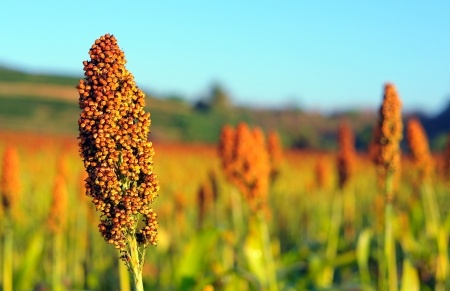
Sorghum (Sorghum bicolor (L.) Moench) is not a novelty crop by any means. It was grown by the ancient Egyptians nearly 4,000 years ago and is probably even older under cultivation. The interest comes as African populations continue to grow and there is a strong necessity to find suitable crops to feed an ever growing population. It could, along with cowpea, pigeon pea and other crops supplement maize or corn cultivation in those part of the world where there is a strong dependency on one crop. It might also be answer to climate change as lands become more arid. It is probably one of the few crops that can provide both grain and stem for use as a raw material in the production of ethanol and sugar, syrups, cattle fodder, a fuel, roofing, paper manufacture, fencing and bedding.
Commercial Value
Sorghum is now the third most important cereal in the USA and generally the fifth biggest worldwide based on stats from the US Grains Council and the UN Food And Agriculture Organisation (FAO). The grain has the capability to live under harsh growing conditions and appears readily adaptable in those situations. It is ideal for arid, semi-desert regions especially in African and Southern Asia. It also forms a good fodder crop. The crop in many of these areas is not just a food staple but also a primary source of proteins, vitamins and minerals for probably some of the poorest people in the world.
It is of course gluten-free which makes it an increasingly useful food for all those intolerant of gluten!
Sorghum has many names: Great Millet, guinea corn are names found in western Africa whilst the Chinese call it kaolian, the Spanish know it as milo and the Indians call it jowar. Nigerians and Ghanaians produce Burukutu which is a fermented form of sorghum and a potent alcoholic beer. The grains also finds their way into cakes and biscuits.
Sorghum is also an energy crop being a source of biofuel as well as producing food which can be fermented. Bioethanol in particular is produced as an alternative energy source which has the attractiveness of being environmentally friendly as a process and being sustainable and renewable. Unlike other crops this one has a strong genetic profile which makes it ideal for breeding programmes that might extend its application (Rooney, 2014).
Sorghum comes in different forms: Red and White, Wholegrain or puffed.
Processing Sorghum
The traditional methods of processing of sorghum are very much the key nowadays. It involves using both dry and wet heating methods (Murty and Kumar, 1995). Porridge is the most popular dish prepared and this comes in an almost infinite variety of consistency from very soft and watery to extremely think and paste like. The meal used in porridge can be fermented as well as non-fermented. Porridge preparation requires cooking the meal with boiling water. This process varies considerably depending on the type of porridge being made (Taylor et al., 1997).
Other foods made from the grain include flat breads, beers and other alcoholic beverages. A type of popcorn can be prepared and there is a large range of snacks and other dessert-like foods produced.
Fermentation Of Sweet Sorghum Juice
The principle product from fermentation of sweet sorghum is ethanol hence its value as a biofuel source. A number of studies have looked at ethanol production principally using Saccharomyces cerevisiae.
References
Murty, D.S., Kumar, K.A., (1995) Traditional uses of sorghum and millets. In: Dendy, D.A.V., (Ed.), Sorghum and Millets: Chemistry and Technology, American Association of Cereal Chemists, St Paul, MN, pp. 185–221
Rooney, W. L. (2014). Sorghum.In: Cellulosic energy cropping systems, pp. 109-129 Print ISBN: 9781119991946 (Chapter)
Taylor, J.R.N., Dewar, J., Taylor, J., Von Ascheraden, R.F., 1997. Factors affecting the porridge-making quality of South African sorghums. Journal of the Science of Food and Agriculture 73, pp. 464–470.
Leave a Reply